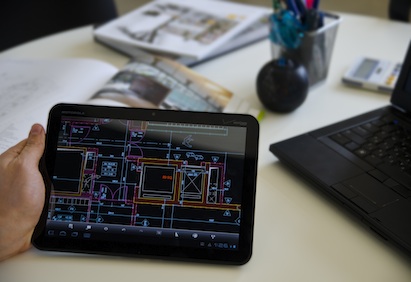Every remodeler knows how important photos are in a sales call. Prospective clients kinda sorta have an idea of what they want, maybe.
There’s an equal chance that they have no clue what they want — they just know that they have now isn’t working. They need to see the Cinderella transformations the remodeler has done for other people.
That’s why remodelers constantly take photos of completed projects. Great pictures sell remodeling. The problem comes in deciding which pictures to put in a portfolio — and paying for the prints.
“I just finished five or six photo shoots with all these gorgeous photos,” says Kristina Ferrigan, marketing director for Hinsdale, Ill.-based Normandy Builders and Architects, which has 15 designers — who each had 50-page portfolios. “Then I started running the numbers and said, ‘This is starting to get crazy.’”
She doesn’t want to print a photo of every backsplash and faucet, but she needs new photos as certain styles become dated. So do the portfolios themselves.
“It starts to look like it has been dragged around people’s homes because it has,” she says. “It loses crispness.”
And the books become huge. As Case Design Remodeling executive vice president Bill Millholland put it, “You look like a pilot carrying this briefcase on wheels.”
In almost a collective light bulb moment across the country, remodelers figured out that as a way to present photos to prospective clients, an iPad was just about the greatest invention since ice cream on a stick.
“I love the zoom-in feature on the photos,” says Anne Higuera, co-owner of Ventana Construction LLC, a high-end remodeling firm in Seattle. “You can see the details. It’s been a revolution in the way we show people what we do.”
She also appreciates its speed. “It’s amazing how fast it is,” she says. “The laptop takes so much longer to wake up. There’s nothing worse than telling someone you’re going show them something on the computer. Everyone is standing there waiting and you feel stupid.
A host of uses
Putting photos on the iPad allows designers to have many more photos to show prospective clients and they can be searched by rooms, styles, colors or features of interest to individual clients – chimneys, backsplashes, vent hoods, ceiling details. You can add videos of customer testimonials.
That’s just the start of how tablets can be used in the remodeling sales process.
Vince Weber, a designer with Normandy Builders and Architects and a self-described “techie kind of guy,” bought an iPad shortly after they were introduced. He started out using the iPad just to show prospective clients photos of his projects. Then he added a sketching app to use in pre-sale meetings to do hand renderings for prospective clients.
“That spilled into a bunch of other things,” he says. He started organizing his photos into categories. Then he started tracking his clients through the sales and project process, keeping track of things like how many meetings it took before they made selections, his volumes and closing ratios. Then he found an app to calculate payments for clients.
After the sale, he can search catalogs as PDFs on the iPad instead of carrying a stack of them. He can take notes in meetings and email them immediately.
“If someone is doing a mudroom, I can sketch a rough idea, come up with a cost on the spot, do the change order, email it and have them sign it,” Weber says – all from one device. If he’s 10 minutes early to a meeting, he’ll go onto Zillow.com and check out the neighborhood so that he can make suggestions about the best remodeling options.
He also uses the iHandy level app. He showed it to Ferrigan, who liked what she saw, especially after she watched Weber make changes to a rendering in five minutes on an iPad during a sales meeting.
“Back in the day, it would have taken another meeting,” she says. “That’s your time, and added time in driving. In Chicago, nobody is five minutes away. To be able to subtract a potential meeting – that’s big. It also reduces the chance of the client talking to a competitor. … I can’t imagine how it won’t have an impact on the sales process. How can it not?”
Big impact
It already is. Rick Storlie is a sales trainer and virtual sales manager for two design/build remodeling firms and several builders. He significantly changed his sales process after he put a Power Point presentation on an iPad and noticed how prospective customers responded to the technology.
“We’d be talking about the scope of work and the budget and jump into photo albums of projects we had done,” he says. “Their focus was so intense on what we had done for other clients, the conversation completed pulled away from price to talk about what we do and how we do it.”
As a result, he’s changed the sales process in initial meetings from asking for a full plan deposit to asking for a $250 design consultation.
“We’re converting over 50 percent of customers from the first meeting and closing about 80 percent of design consultations,” he says. “It’s worked wonders. Is it all the iPad? No, but it’s allowed us to
educate them versus talking about their kitchen, how much we could do and what it would cost. As soon as you do that, they talk about price.”
Retailing in the $500 range, tablet technology isn’t just for major remodelers such as Case Design and Normandy. Dallas-based web consultant Scott Haley works with several “one-truck guys” who he says are using iPads just like the big players.
Some of Haley’s clients have quickly figured out that an iPad 2 can be a great way to save time and money driving back and forth across the expansive Dallas-Fort Worth metroplex. Instead of sending two people for a meeting, remodelers will send one person with an iPad 2 and videoconference with the web cam.
“They’ll pan around the kitchen and say, ‘What do you think?’” Haley says. “That’s pretty Buck Rogers in the 25th century, as one of my guys put it.”
Ringing up sales
Remodelers are even using their tablets to process payments. Until she got an iPad for her birthday, kitchen and bath designer Cheryl Daugvila, president Cheryl D. and Company in LaGrange, Ill., had a strict ‘cash and checks’ payment policy because she didn’t want to pay for a merchant account.
“On smaller purchases, I knew I lost some business because we didn’t take credit cards,” Daugvila says. “Small things add up.”
Then she set up her iPad with the Square credit card swiper for purchases up to $1,000. She can take credit cards without being charged a monthly minimum fee. Since she started taking credit cards, she’s sold a vanity to one customer, hardware to another and “a few add-ons” to a customer who had previously bounced a check.
“The Square reader has incredibly opened up the opportunities for companies like me that normally just take cash and checks,” she says. “It makes it easy for people who are too busy to meet with me. It’s so easy to whip out a credit card – and they spend more. I’m the same way. I want the points.”
The drawbacks
Of course, nothing can be perfect. If there is a drawback, it’s that the multitude of options available for a tablet can become paralyzing. Setting up the iPad for the first time was a little overwhelming for Ferrigan.
“If you’re overexcited about it, which I am, you’re like a kid on Christmas hopped up on sugar,” she says. “You need to slow down, take your time and build something that’s rock solid. … I’m wary of creating things people don’t need.”
There also have been glitches with third-party software and applications. Higuera has had problems trying to migrate before-and-after photos she had set up in folders on a PC onto the iPad, which reorganized them alphabetically and by date. “I haven’t found a solution to organizing them the way I want to,” she says.
And then there’s the question of who gets a tablet and who doesn’t. In what amounted to self-defense, Case Design Remodeling provided a $300 subsidy to its sales agents to buy their own.
“We had two in one office and two in another,” Millholland says. “Fights broke out. We decided to not go out and buy them for people, but to subsidize them for people. We said, ‘It’s your device, you own it.’ We’re to 100 percent adoption across 20 salespeople.”
Besides using their iPads for portfolios, the Case Design Remodeling staff uses the Dropbox program on the iPad to organize collateral material.
“We get a lot of stuff from manufacturers,” Millholland says. “It’s impossible to have all that with you when you visit a client. Now we can have all that stuff with us all the time. It’s pretty cool.”
He also uses it with clients for preliminary budgeting. “When you’re out with a client, everybody wants to know how much the job will cost. Instead of just taking a swing at it, you can have a fairly meaningful conversation about a budget range. “
“With clients, you can hand it to them and in no time, they understand the interface,” Millholland says. “It’s really easy to use. You just sort of get it. The screen is nice enough that the photos look great. It allows us to carry an incredible amount of information, and it’s only going to get better.”
Instant connections
Like many users with both an iPhone and an iPad, Ventana Construction’s Higuera uses the iPhone to create a wireless hot spot for the iPad. With that, she can log in to the company’s online project management tool, BuilderTREND, to do things like post change orders, where the client can approve them with electronic signatures.
“There’s less paper floating around,” the Seattle-based remodeler says.
She uses the internet to connect to both her lumber yard to check on pricing and orders and county government sites. There, she can research GIS maps, check the county assessor’s office for open or expired permits, to make sure their requests for inspections have been received and to see if they passed inspections, get past pricing information and look at old photos of house.
“I love the old photos on the county website to see what the house used to look like,” she says. “If they want to bring the house back to where it was, we know which direction to go.”
Her clients may want to go back in time with their houses, but Higuera definitely is looking forward with her tablet.
“It’s one of the most amazing things I’d ever seen,” Higuera says. “Suddenly everything is in one box. You don’t need any other tools — except a hammer.”
Tablets may just be the ideal tool for selling and designing jobs
Add new comment
Related Stories
How to Create a World-Class Remodeling Team
Great remodeling companies position themselves for the future with the right players
Everyone Should Have a Number: KPIs for Your Design Build Team
Measuring key performance indicators guides your team to success while creating accountability and ownership
How to Revamp Your Pre-Construction Process
Experiencing too much slippage and delays? See how Bridget Bacon of Red House Design Build solved these issues by improving the remodeler's pre-construction process
How This Remodeler Revamped Their Pre-Construction Process
Bridget Bacon of Red House Design Build outlines how she helped transform the pre-construction process for improved finances and morale
Building A Small Projects Division from the Ground Up
Through hard work and careful strategy, Harth Home Services has seen big growth
A Mindset of Serving Others
A research study shows surprising results about what makes us take ownership of our work.
3 Keys to Successful Team Management
On this episode of Women at WIRC, hear Laura Burnes delve into her approach to leadership and project management, in addition to sharing insights into Adams + Beasley Associates' winning culture.
4 Steps to Prep Your Business for Contraction
How a remodeling company plans ahead for the worst of times (and the best of times)
Helping Remodelers 'Get Their House In Order'
From remodeler to NARI executive to industry consultant, Diane Welhouse uses her expertise to help business owners













